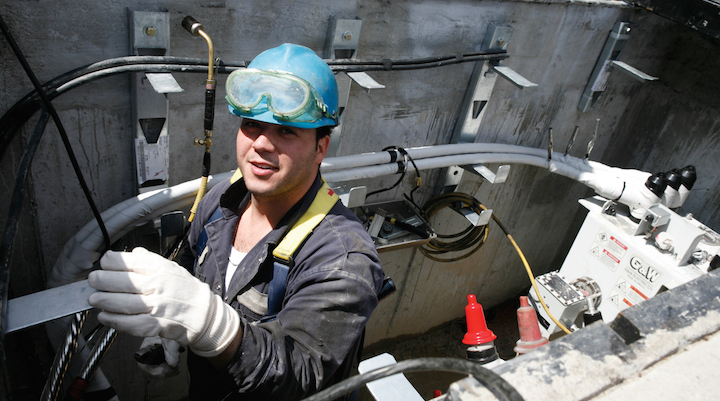
Build Back Better Investments Will Create Jobs Across the Country

The Build Back Better Act is a Jobs Bill
We researched the job creation potential of a number of policies in the Build Back Better Act including: manufacturing; clean water; transmission; community and worker resilience; municipal buildings, schools, and hospitals; and transit. These are just some of the ways Build Back Better will create good-paying jobs.
The Build Back Better Act is a big deal for workers and the climate. The significant investments in manufacturing, clean energy, infrastructure, and the care economy will put our nation on a path to a clean, prosperous, and equitable economy—built for America, by America. The bill makes investments to deploy clean energy and clean vehicles—with strong labor and domestic content standards—and to support the growth of clean technology manufacturing and supply chains, modernize our infrastructure, support the care economy, and reinvest in workers and communities.
Together with the investments from the Infrastructure Investment and Jobs Act (IIJA), these measures will support existing and create millions of new good-paying, union jobs across the country and fight climate change and economic and racial inequity. They must not be watered down or stripped as the bill advances.
We cannot wait any longer to build back better. Congress should pass this bill and send it to the president’s desk.
This site explores the job creation benefits from several key investments in the Build Back Better Act as it stands today. In addition to the priorities explored here, the Build Back Better Act has a number of additional provisions that the BlueGreen Alliance supports and that will create quality, family-sustaining jobs, including:
- More than $550 billion to support clean energy development and fight climate change;
- $320 billion in clean energy tax credits with labor and domestic content standards that support the growth of good family-supporting jobs and domestic manufacturing in the clean economy and an electric vehicle (EV) tax credit that will lower the cost of purchasing Eps and speed the deployment of EVs made in America by union workers;
- $110 billion to spur new domestic supply chains and the manufacturing of technologies—like solar, batteries, and advanced materials—while modernizing and cutting emissions from essential basic industries like steel, cement, and aluminum;
- $150 billion in our care economy to ensure that our physical and social infrastructure are resilient in the face of climate change or other crises moving forward; and
- A major investment in clean procurement, a critical element of the BlueGreen Alliance’s Buy Clean concept, which rewards companies that utilize cleaner methods to make the materials we need to repair and modernize our infrastructure in cleaner ways.

Infrastructure Investment and Jobs Act (IIJA)
The IIJA was signed into law in November 2021, and was a bipartisan agreement that included investments in many different sectors of our nation’s infrastructure systems. Together with the investments from the Build Back Better Act, they complete the president’s Build Back Better Agenda. These measures will create good-paying, union jobs across the country and fight climate change and economic and racial inequity.
Transit
Transit funding received a significant investment of $39 billion in the IIJA, but more is needed to meet the current $176 billion backlog in transit needs. The $39 billion investment in the IIJA will result in 204,750 direct, 131,820 indirect and 185,250 induced jobs, a total of 521,820 jobs over 10 years.
The $39 billion in the IIJA and $19.75 billion in the Build Back Better Act would result in 308,437 direct, 198,575 indirect, and 279,062 induced jobs, a total of 786,074 jobs over 10 years.

Environmental Remediation
The IIJA included a significant investment of $21 billion for environmental remediation, including $15 billion to clean up abandoned mines and orphaned wells and $5 billion for the Superfund and Brownfields programs.The Build Back Better Act does not include additional direct funding for these programs.
Cleaning up abandoned mines and orphaned oil and gas wells in the U.S. is an example of how America’s environmental challenges can also be economic opportunities. Reclamation not only remediates the host of environmental and public health problems associated with these sites but also frees up that land for new, more sustainable economic development opportunities in industry sectors like agriculture, recreational tourism, manufacturing, and even clean energy production. Immediate job opportunities are also created doing the reclamation work.
The $21 billion investment in the IIJA would result in 57,120 direct, 38,220 indirect, and 56,910 induced jobs, a total of 152,250 jobs over 10 years.
Worker & Community Resilience
The IIJA includes $1 billion for the Federal Emergency Management Agency’s (FEMA) Building Resilient Infrastructure and Communities (BRIC) program, $3.5 billion for FEMA’s Flood Mitigation Assistance program, and $492 million for the National Oceanic and Atmospheric Administration’s (NOAA) National Coastal Resiliency Fund. The $4.992 billion investment in FEMA and NOAA programs in the IIJA would result in 36,791 direct, 17,172 indirect, and 29,303 induced jobs, a total of 83,266 jobs over 10 years.
MUSH (Municipal Buildings, Universities, Schools, and Hospitals)
The Infrastructure Investment and Jobs Act (IIJA) included $250 million for the State Energy Program to retrofit commercial (and residential) buildings including MUSH. Combined with the $500 million with the Build Back Better Act, this would result in 19,687 direct, 12,675 indirect, and 17,812 induced jobs, a total of 50,174 jobs over 10 years.
Transmission
The Infrastructure Investment and Jobs Act (IIJA) included $2.5 billion for transmission build out, which is far below what is needed to build and upkeep new and existing lines. That $2.5 billion is expected to leverage $2.5 billion in private for a total of $5 billion, which would create 30,850 direct, 10,150 indirect, and 23,450 induced jobs, a total of 65,000 jobs over 10 years.